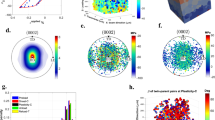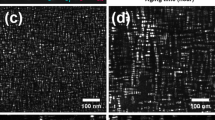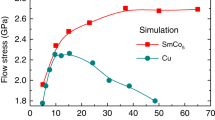Abstract
DURING investigations of dislocation behaviour in a polycrystalline zinc a number of interesting facts were found. (All experiments were performed at room temperature and specimens 6 mm2 × 12 mm were machined from a commercially pure zinc cast of the composition shown in Table 1. Specimens were annealed at 350° C for 5 h and furnace-cooled to a grain size of American Society for Testing Materials micro-grain size No. 00 (except for one shown in Fig. 1 which was not annealed). The polishing and etching reagents for revealing grain boundaries and dislocations were similar to those used by J. J. Gilman1): (1) Twin formation and the movement of grain and twin boundaries besides crystallographic glide are responsible for a large plastic flow of this metal during uniaxial stressing, creep, relaxation and fatigue testings, as is shown in Fig. 1. (2) By the application of high hydrostatic pressure of the order of thousands of atmospheres, dislocations line up along grain boundaries. Twin formation is suppressed to a great extent and grain boundary movement is completely blocked. However, multiplication and movement of dislocations are still persistent and cause a plastic strain of the order of one ten-thousandth. Fig. 2 shows the build-up of dislocation walls along grain boundaries and dislocation line-ups in crystals with the application of hydrostatic pressure. (3) Once the aforementioned structure of dislocations is formed the zinc specimen is greatly strengthened: the result of uniaxial compression tests showed that the stiffness was increased by 20 per cent when a specimen was pressure-treated at 3,000 atm. for 1 h. When an initial compressive load of 70 kg was applied at a cross-head speed of 0.5 mm/min and the cross-head held still for several hours, the relaxation of load was observed to reduce to 2.3 kg for a pressure-treated specimen from 14.2 kg for a non-treated one.
This is a preview of subscription content, access via your institution
Access options
Subscribe to this journal
Receive 51 print issues and online access
$199.00 per year
only $3.90 per issue
Buy this article
- Purchase on Springer Link
- Instant access to full article PDF
Prices may be subject to local taxes which are calculated during checkout
Similar content being viewed by others
References
Gilman, J. J., J. Metals, Trans. Amer. Inst. Met. Eng., 6, 998 (1956).
Author information
Authors and Affiliations
Rights and permissions
About this article
Cite this article
INOUE, N., NISHIHARA, M. A Strengthening Effect of High Hydrostatic Pressure on Grain Boundary Walls of a Polycrystalline Zinc. Nature 207, 1188–1189 (1965). https://doi.org/10.1038/2071188b0
Published:
Issue Date:
DOI: https://doi.org/10.1038/2071188b0
Comments
By submitting a comment you agree to abide by our Terms and Community Guidelines. If you find something abusive or that does not comply with our terms or guidelines please flag it as inappropriate.



